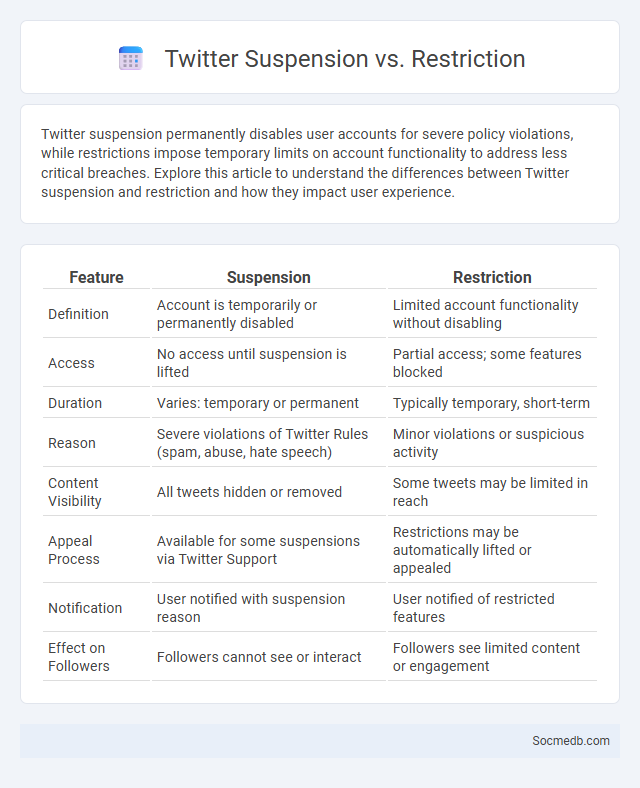
Photo illustration: Twitter Suspension vs Restriction
Twitter suspension permanently disables user accounts for severe policy violations, while restrictions impose temporary limits on account functionality to address less critical breaches. Explore this article to understand the differences between Twitter suspension and restriction and how they impact user experience.
Table of Comparison
| Feature | Suspension | Restriction |
|---|---|---|
| Definition | Account is temporarily or permanently disabled | Limited account functionality without disabling |
| Access | No access until suspension is lifted | Partial access; some features blocked |
| Duration | Varies: temporary or permanent | Typically temporary, short-term |
| Reason | Severe violations of Twitter Rules (spam, abuse, hate speech) | Minor violations or suspicious activity |
| Content Visibility | All tweets hidden or removed | Some tweets may be limited in reach |
| Appeal Process | Available for some suspensions via Twitter Support | Restrictions may be automatically lifted or appealed |
| Notification | User notified with suspension reason | User notified of restricted features |
| Effect on Followers | Followers cannot see or interact | Followers see limited content or engagement |
Understanding Twitter Account Actions: Suspension vs. Restriction
Twitter account suspension permanently removes access due to violations of platform policies such as spam, abusive behavior, or security risks. Restrictions, by contrast, temporarily limit specific account functionalities like tweeting or following to address minor infractions or suspicious activities. You should carefully review Twitter's community guidelines and appeals process to resolve issues related to account suspension or restriction effectively.
What is a Twitter Suspension?
A Twitter suspension refers to the temporary or permanent disabling of a user's account due to violations of Twitter's Rules and Policies, such as spamming, abusive behavior, or spreading misinformation. Suspended accounts lose the ability to tweet, retweet, like, or follow until the suspension is lifted or removed. Twitter enforces suspensions to maintain platform safety, prevent harassment, and ensure compliance with legal standards.
Key Reasons Why Twitter Suspends Accounts
Twitter suspends accounts primarily for violating platform policies such as spreading misinformation, engaging in hate speech, or promoting harassment. Automated detection systems and user reports trigger investigations into suspicious behaviors like spam, fake accounts, or coordinated inauthentic activity. Understanding these key reasons helps you maintain compliance and avoid suspension on Twitter.
What Does a Twitter Restriction Mean?
A Twitter restriction limits a user's ability to interact on the platform, including tweeting, retweeting, and liking content, often due to violations of Twitter's rules on spam, harassment, or misinformation. These restrictions can last from a few hours to several days, depending on the severity and frequency of the offenses, impacting user engagement and visibility. Users under restriction may receive notifications explaining the reason and duration, encouraging compliance with Twitter's community guidelines to regain full access.
Common Causes for Twitter Restrictions
Twitter restrictions commonly arise from violations such as posting harmful content, spreading misinformation, or engaging in abusive behavior. Your account may face temporary or permanent suspensions if you share spam, fake news, or violate platform policies regarding hate speech and harassment. Understanding these rules helps you maintain a positive presence and avoid disruptions on Twitter.
Differences Between Suspension and Restriction on Twitter
Twitter suspension permanently disables an account due to severe policy violations such as hate speech, harassment, or repeated spam activities. Restrictions temporarily limit specific account features like tweeting, retweeting, or liking posts, often imposed for minor infractions or suspicious behavior. Understanding these differences helps users navigate Twitter's enforcement actions and maintain compliance with the platform's community guidelines.
Temporary vs. Permanent Suspension Explained
Temporary suspension on social media platforms restricts user access for a limited period, often due to policy violations like inappropriate content or spamming, allowing the user to resume activity after the suspension ends. Permanent suspension, also known as a ban, results in indefinite account deactivation due to severe or repeated breaches of community guidelines, permanently removing the user's presence and content from the platform. Understanding the distinctions helps users recognize consequences and take corrective actions to maintain compliance with platform rules.
How Twitter Notifies Users About Account Actions
Twitter notifies users about account actions through real-time alerts and notifications on their mobile app or email, ensuring timely awareness of activities such as login attempts, password changes, and security updates. These notifications are designed to enhance account security by prompting immediate user verification or required actions if suspicious behavior is detected. Customizable settings allow users to control which types of notifications they receive, improving personalized account management and protection.
Steps to Appeal a Twitter Suspension or Restriction
To successfully appeal a Twitter suspension or restriction, start by logging into your account and navigating to the Twitter Help Center's suspension appeal form. Provide a clear and concise explanation of your case, including any relevant details or evidence supporting your claim, and avoid violating Twitter's Terms of Service during your appeal. After submitting your appeal, monitor your email for Twitter's response, which may take several days, and be prepared to follow any further instructions to restore your account.
Protecting Your Twitter Account from Penalties
Implement strong security measures such as enabling two-factor authentication and using complex, unique passwords to protect your Twitter account from penalties. Regularly review Twitter's policies to ensure compliance with community guidelines, avoiding behavior that could trigger suspensions or restrictions. Monitor account activity for suspicious logins or unauthorized access to prevent violations that lead to account penalties.
 socmedb.com
socmedb.com